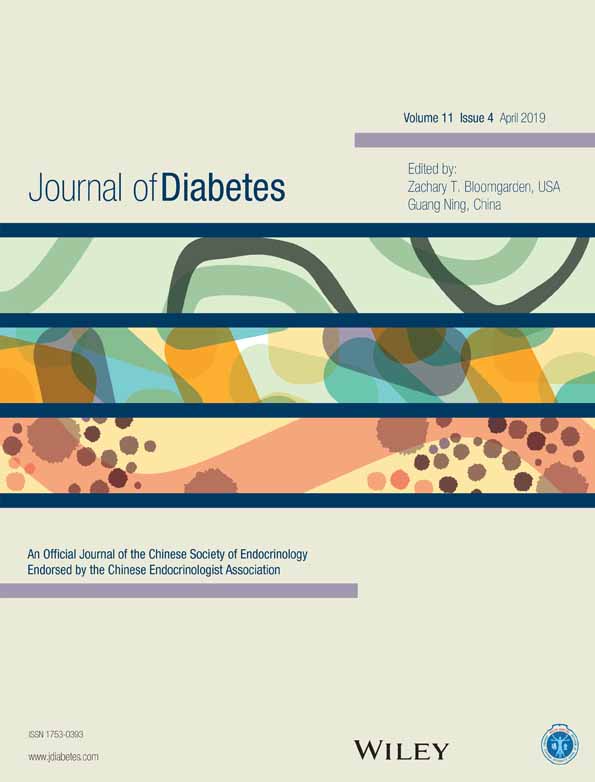Crossing family histories of diabetes and cardiovascular disease leads to unexpected outcomes in diabetic offspring
糖尿病与心血管疾病交叉家族史可使糖尿病后代出现意料之外的结果
Abstract
enBackground
This study investigated the isolated and crossed effects of familial histories (FH) of early onset coronary heart disease (EOCHD) and type 2 diabetes mellitus (T2DM) on diabetic offspring.
Methods
The cardiometabolic phenotype of 1098 T2DM patients was analyzed according to an FH of T2DM and/or EOCHD, including body composition, fasting insulinemia, insulin sensitivity, β-cell function (BCF), lipids, lipoprotein(a), high-density lipoprotein (HDL) number and functionality, and micro- and macrovascular complications.
Results
Mean age and T2DM duration were 69 and 18 years, respectively; 64% of patients were male, 50% (n = 550) had an FH of T2DM (DM[+]), and 13% (n = 145) had an FH of EOCHD (EOCHD[+]). Four subgroups were generated by crossing FHs: DM[−]EOCHD[−] (44%; n = 487); DM[+]EOCHD[−] (42%; n = 466); DM[−]EOCHD[+] (6%; n = 61); and DM[+]EOCHD[+] (8%; n = 84). Microangiopathies were highest among DM[+] patients, whose BCF was deteriorating the fastest. More numerous/dysfunctional HDLs characterized EOCHD[+] patients. The greatest frequency of cardiovascular disease (CVD; 69%) was observed in DM[−]EOCHD[+] patients, whose lipoprotein(a) and insulinemia were also highest (81 nmol/L and 140 pmol/L, respectively). The lowest frequency of CVD (30%) was observed in DM[+]EOCHD[−] patients.
Conclusions
Familial histories of DM and EOCHD predispose to increased microvascular and macrovascular risk, respectively, with hyperinsulinemia, lipoprotein(a), and dysfunctional HDLs standing out as mediators of the inherited macrovascular risk. Yet, crossing these FHs did not randomly redistribute vascular risk, because patients with parental T2DM had fewer macrovascular diseases regardless of familial EOCHD. The odds of being left-handed were unexpectedly greater in patients with crossed parental histories.
Abstract
zh摘要
1.1 背景
这项研究调查了早发冠心病(early onset coronary heart disease,EOCHD)与2型糖尿病家族史对糖尿病后代有何独立影响以及交叉影响。
1.2 方法
按照2型糖尿病和/或EOCHD家族史进行分层, 分析了1098名2型糖尿病患者的心脏代谢表型, 包括身体成分、空腹血胰岛素、胰岛素敏感性、β细胞功能、脂质、脂蛋白(a)、高密度脂蛋白(HDL)数量与功能以及微血管与大血管并发症。
1.3 结果
2型糖尿病患者的平均年龄与病程分别为69岁与18年;64%的患者为男性,50%的患者(n = 550)有2型糖尿病家族史(DM[+]),13%的患者(n = 145)有EOCHD家族史(EOCHD[+])。根据交叉的家族史产生了4个亚组:DM[−]EOCHD[−](44%;n = 487);DM[+]EOCHD[−](42%;n=466);DM[−]EOCHD[+](6%;n = 61);以及DM[+]EOCHD[+](8%;n = 84)。在DM[+]患者组中微血管病变最高, 他们的β细胞功能恶化最快。EOCHD[+]组患者的特征为HDLs数量更多/功能失调更明显。观察到的心血管疾病(CVD;69%)发生率最高的是DM[−]EOCHD[+]组患者, 他们的脂蛋白(a)与血胰岛素水平也是最高的(分别为81 nmol/L与140 pmol/L)。观察到CVD发生率最低(30%)的是DM[+]EOCHD[−]组患者。
1.4 结论
DM与EOCHD家族史分别容易导致微血管与大血管风险增加, 并且遗传性大血管风险的介质是高胰岛素血症、脂蛋白(a)与功能失调的HDLs。然而, 这些家族史交叉并不会导致血管风险随机重新分布, 因为父母患有2型糖尿病的患者无论是否有家族性EOCHD他们的大血管疾病都较少。出乎意料的是在父母有交叉病史的患者中出现左撇子的几率更大。




